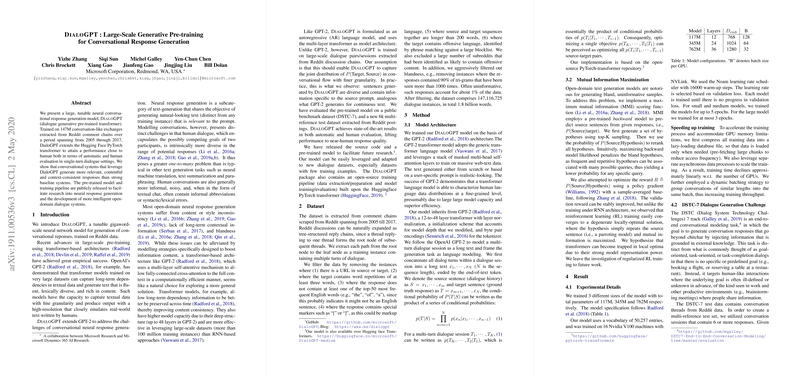DialoGPT: Large-Scale Generative Pre-training for Conversational Response Generation
The paper "DialoGPT: Large-Scale Generative Pre-training for Conversational Response Generation" introduces a neural conversational response generation model, DialoGPT, and evaluates its performance against baseline systems. This model leverages the architecture of the GPT-2 transformer and adapts it specifically for dialogue generation tasks. The discussion throughout the paper provides a deep dive into the dataset, model architecture, training methodology, evaluation criteria, and the outcomes from various experimental setups.
Introduction and Methodology
DialoGPT extends the architectures and methodologies established by models such as GPT-2, addressing the specific challenge of generating contextually relevant and content-rich conversational responses. The model is trained on a substantial dataset comprising 147 million conversational exchanges scraped from Reddit spanning 2005 to 2017. This rich dataset enables DialoGPT to capture the diversity and informal nature of human dialogue.
The model itself inherits the autoregressive design of GPT-2, where a multi-layer transformer architecture allows for efficient learning of long-term dependencies in text. DialoGPT integrates multiple turns of dialogue as a single long text to effectively model multi-turn interactions, a critical aspect given the one-to-many nature of conversational responses. The architecture also incorporates a Maximum Mutual Information (MMI) criterion to further enhance response diversity and relevance.
Dataset and Training
The dataset preparation process involved meticulous filtering to remove non-conversational and offensive content, ensuring a high-quality corpus. The preprocessing phase also eliminated repetitive and bland responses to increase the overall informativeness of responses generated by the model.
The training utilized a large-scale infrastructure, employing up to 48-layer transformers with parameter configurations of 117M, 345M, and 762M across multiple Nvidia V100 GPUs. Techniques like dynamic batching, lazy-loading of data, and asynchronous data processes optimized the training throughput and efficiency.
Evaluation and Results
The evaluation comprises both automatic metrics and human judgments. DialoGPT's performance on the DSTC-7 dialogue generation challenge demonstrated its superiority over baseline systems. It achieved state-of-the-art results in automatic metrics such as BLEU, METEOR, NIST, Entropy, and Dist-n, often surpassing or nearly matching human performance. Interestingly, rigorous human evaluations revealed that Meta-reinforcement learning models produced more contentful and relevant responses compared to traditional RNN-based models.
In a comparative analysis, models fine-tuned from the pre-trained GPT-2 outperform those trained from scratch, underscoring the benefits of large-scale pre-training. The DialoGPT (345M) model, with MMI re-ranking and beam search, exhibited a balanced combination of diversity, relevance, and human-likeness, appealing more in several categories than even human responses, likely due to its moderation of extreme responses common in real human dialogues.
Implications and Future Work
The implications of this research are manifold. Practically, DialoGPT can serve as a foundational component in building intelligent open-domain dialogue systems with applications ranging from virtual assistants to automated customer support. Theoretically, the findings emphasize the efficacy of transformer architectures in capturing conversational nuances, paving the way for more sophisticated models that can understand and generate human-like dialogue.
Future work could explore the implementation of controlled response generation to mitigate biases and offensive content. Additionally, reinforcement learning techniques may be employed to further fine-tune response generation, ensuring greater relevance and user engagement. The public release of both the model and the training pipeline facilitates further innovations and applications in conversational AI research.
In conclusion, DialoGPT represents a significant advancement in generative pre-training for conversational systems, providing a robust and adaptable framework for further exploration and application in the field of natural language processing. The model’s superior performance across multiple metrics and the availability of the training infrastructure marks a critical step towards more human-like and interactive AI systems.
